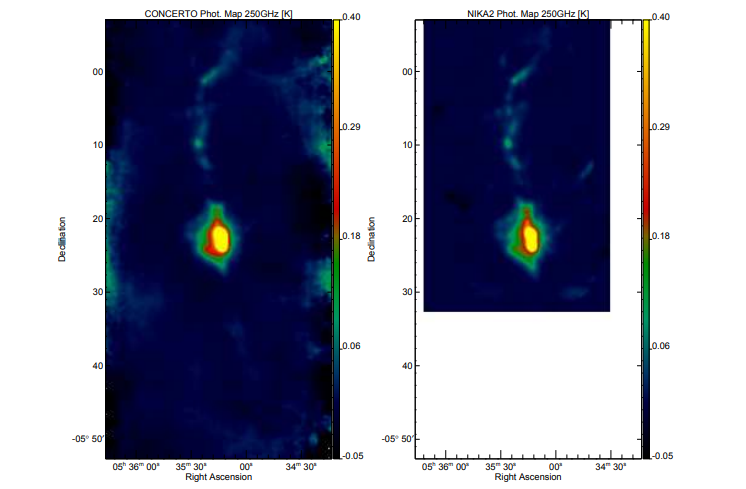
Why is the observation and detection of water vapor and carbon monoxide important for understanding the interstellar medium?
Observing the spectral lines of molecules such as carbon monoxide (CO) and water vapor opens a window into the invisible world of galactic gas. Molecular hydrogen (H₂), the most abundant molecule in interstellar clouds, does not emit detectable radiation at the very low temperatures (10–50 K) typical of these environments. In contrast, carbon monoxide — the second most abundant molecule in the interstellar medium — possesses a dipole moment and therefore emits significant radiation in the millimeter wavelength range. By observing CO emission lines in this range, astronomers can determine the mass, density, and distribution of molecular gas, even in crowded star-forming regions such as the Orion Nebula.
Water vapor, however, tells a different story. In star-forming regions, water vapor forms when the thin icy coatings on interstellar dust grains evaporate due to heating or shock waves triggered by the ignition of nuclear fusion in newly formed stars. Thus, detecting water vapor emission lines in the millimeter range in certain regions of the Orion Nebula indicates that interstellar dust grains in those areas are experiencing elevated temperatures. This radiation, originating from the rotational transitions of water molecules, makes water vapor an effective coolant for warm molecular gas (around 100 K), as it allows the gas to shed excess energy and return to the ground state.
Millimeter-wavelength observations of water vapor therefore provide crucial information about where and how efficiently the interstellar medium is losing heat. In this study, for example, water vapor emission was detected only in the central regions of the Orion Nebula, indicating that dust desorption and gas cooling are localized in this central area. In summary, CO emission traces the reservoirs of molecular gas, while water vapor emission reveals thermal processes in the interstellar medium — such as dust heating and gas cooling. Together, they offer a more complete picture of the complex dynamics of the interstellar environment in a corner of our galaxy.
What instruments and telescopes did you use in this study? Which nebula did you observe?
This study is based on data collected by two telescopes:
- CONCERTO, an instrument installed on the 12-meter APEX telescope in Chile, operated between 2021 and 2023. This camera covers wavelengths from approximately 1 to 2 millimeters and uses 4,000 kinetic inductance detectors (KIDs). With a field of view of about 17 arcminutes and an angular resolution of about 30 arcseconds, CONCERTO is capable of capturing both continuum and spectral line emission.
- NIKA2, an instrument mounted on the 30-meter IRAM telescope in Spain. NIKA2 uses similar technology to CONCERTO but offers higher angular resolution (12 arcseconds) and a smaller field of view (6.5 arcminutes). It operates in the 1–2 mm wavelength range.
The focus of this study was a bright star-forming region in the northern part of the Orion giant molecular cloud. Located at a distance of 414 parsecs from the Sun, this nebula is an ideal target for studying how star formation impacts the interstellar medium. For the first time, and within just 2.5 hours of observing time, the CONCERTO instrument simultaneously detected continuum emission from dust, as well as spectral emission lines from CO and water vapor, all in the Orion Nebula.
Using this dataset, in combination with NIKA2 observations and models of interstellar dust, we derived the dust emissivity index across the nebula and examined how it varies between regions. This index offers valuable insight into the evolution of dust in different environments within a galaxy and can help refine the physical models used to describe interstellar dust.

Photometric map of the Orion constellation observed with the CONCERTO (left) and NIKA2 (right) instruments at a frequency of 250 GHz. Both maps have been convolved to a common angular resolution of 40 arcseconds.
Back to the main page